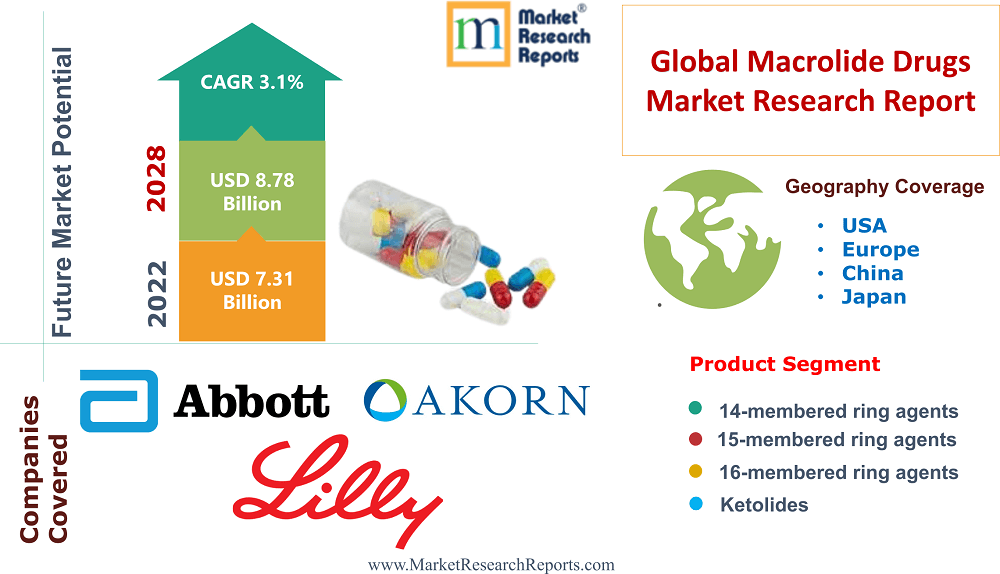Macrolide Antibiotic Market: Opportunities and Challenges

Macrolide drugs are a type of antibiotic that is used to treat bacterial infections. They work by inhibiting the synthesis of proteins in bacteria, which leads to the death of the bacteria. Macrolide drugs are effective against a wide range of bacteria, including those that cause pneumonia, bronchitis, and some sexually transmitted infections. Some common examples of macrolide drugs include azithromycin, erythromycin, and clarithromycin. They are typically taken orally and can be used to treat both acute and chronic infections. Side effects of macrolide drugs may include gastrointestinal upset, rash, and allergic reactions.
1 . Macrolide Drugs Manufacturing
- Macrolide drugs are a class of antibiotics that are produced through fermentation processes. This involves the use of a specific type of microorganisms, such as a fungus or bacterium, to produce the active ingredient in the drug.
- The process typically begins with the selection and isolation of the microorganism that produces the desired macrolide antibiotic. The microorganism is then grown in a controlled environment, such as a fermentation tank, where it is provided with the necessary nutrients and conditions to produce the active ingredient.
- Once the fermentation process is complete, the macrolide antibiotic is extracted from the microorganism and purified through a series of chemical processes. The purified active ingredient is combined with other inactive ingredients to form the final macrolide drug product.
- The manufacturing process is carefully controlled and monitored to ensure the quality and purity of the final product. The finished macrolide drug is then packaged and labeled for distribution and sale.
2 . Macrolide Antibiotic Market Overview
Reports Suggested for Macrolide Marketers/Manufacturers
3 . Macrolide Antibiotic Market Segment
- Cyclization agents: These agents facilitate the formation of rings by reacting with the functional groups on the molecule. Examples include dicyclohexylcarbodiimide (DCC), 1,3-dicyclohexylcarbodiimide (DCI), and 1,4-dicyclohexylcarbodiimide (DCCI).
- Ring-closing metathesis (RCM) catalysts: These catalysts are used in a reaction called ring-closing metathesis, which involves the opening and closing of rings to form larger rings. Examples include Grubbs' catalyst and Hoveyda-Grubbs' catalyst.
- Multicyclic ring synthesis (MRS) reagents: These reagents are used to form multiple rings in a single reaction. Examples include bis-indole synthesis (BIS) and bis-indole-2-carboxylic acid (BIA).
- Ring-forming reactions: These reactions involve the formation of rings by the reaction of functional groups on the molecule. Examples include Diels-Alder reactions and Michael reactions.
Reports Suggested for Macrolide Market Investors
4 . Macrolide Antibiotic Drug Opportunities
- Treatment of respiratory tract infections, such as pneumonia and bronchitis
- Treatment of sexually transmitted infections, such as chlamydia and gonorrhea
- Prevention and treatment of bacterial infections in immunocompromised individuals, such as those with HIV or undergoing chemotherapy
- Treatment of skin infections, such as impetigo and folliculitis
- Treatment of Helicobacter pylori infections, which can cause stomach ulcers
- Treatment of infections caused by Mycobacterium avium complex (MAC), which can affect individuals with compromised immune systems
- Prevention of bacterial infections in individuals undergoing surgical procedures.
5 . Macrolide Antibiotic Drug Challenges
- Resistance: Overuse and misuse of macrolides can lead to the development of antibiotic resistance in bacteria.
- Adverse effects: Some individuals may experience adverse effects such as gastrointestinal discomfort, allergic reactions, and hearing loss when taking macrolides.
- Interactions with other medications: Macrolides can interact with certain medications, such as statins and blood thinners, which may alter their effectiveness or increase the risk of adverse effects.
- Limited efficacy against certain infections: Macrolides may not be effective against certain types of infections, such as those caused by fungi or viruses.
- Limited availability: In some regions, access to macrolides may be limited due to cost or lack of availability.
6 . Macrolide Antibiotic Leading Drugs and Players
- Macrolide antibiotics, such as erythromycin and azithromycin, which inhibit bacterial protein synthesis
- Fumagillin, an antimicrobial agent, used in the treatment of certain parasitic infections
- Rapamycin, an immunosuppressive drug used in organ transplantation and cancer treatment
- Cyclosporine, an immunosuppressive drug used in organ transplantation and autoimmune disorders
- Daptomycin, a lipopeptide antibiotic used in the treatment of bacterial infections
- Bafilomycin, an inhibitor of vacuolar ATPase used in cancer research
- Deltamethrin, a pyrethroid insecticide used in pest control
- Moxidectin, a macrocyclic lactone used in the treatment of parasitic infections in animals.
Reports Suggested for Macrolide Chemical/Salt/API Manufacturers
- Global Deltamethrin Market Research Report
- Global Azithromycin Market Research Report
- Global dicyclohexylcarbodiimide (DCC) Market Research Report






